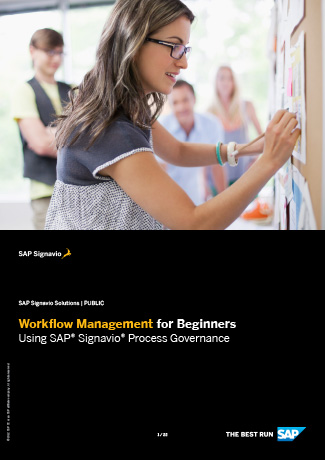Business Process Management vs. Workflow
Workflow is the operational layer of business process management (BPM). While workflows handle task execution, BPM governs the full lifecycle of process design, execution, and optimization.

Workflow is the operational layer of business process management (BPM). While workflows handle task execution, BPM governs the full lifecycle of process design, execution, and optimization.
Workflow and BPM are often used interchangeably, but they serve different purposes. Workflow focuses on coordinating individual tasks, while BPM provides the structure and tools to manage business processes at scale.
This page explains how they relate—and helps you choose the right level of process management for your needs.
A workflow is a sequence of tasks or steps that must be completed to achieve a specific business goal. Workflows are typically rule-based and repeatable, making them ideal for automating routine tasks.
Example: A purchase order workflow might include steps like verifying stock, getting approvals, processing payment, and notifying shipping. These tasks follow a consistent pattern that can be automated using workflow tools.
Workflows improve operational efficiency by reducing manual errors, improving speed, and ensuring consistency in task execution. However, they are often limited to individual functions or departments.
Business Process Management (BPM) is a broader discipline that covers the full lifecycle of managing, improving, and optimizing end-to-end business processes.
BPM includes workflows—but also encompasses process design, governance, analytics, and continuous improvement.
Workflows are a subset of BPM. They represent the execution of specific tasks within a broader process framework.
| Area | Business process management | Workflow |
|---|---|---|
| Scope | End-to-end business processes | Task execution within a process |
| Purpose | Strategic process optimization | Tactical task automation |
| Focus | Governance, modeling, measurement | Task sequence and automation |
| Flexibility | Adaptive, iterative improvement | Fixed task flow |
| Tools | BPM platforms | Workflow automation software |
| Primary users | Process owners, analysts, and leadership | Frontline and departmental teams |
Unlike workflow tools that focus on execution, BPM platforms enable organizations to analyze performance, define KPIs, and ensure process alignment with strategic goals.
→ Related: Business Process Management Benefits
| Use case | You likely need... |
|---|---|
| Aligning processes with strategic goals | BPM platform |
| Standardizing operations across departments | BPM platform |
| Automating repetitive tasks in one team | Workflow tool |
| Managing simple approval flows or checklists | Workflow tool |
| Tracking process KPIs and improvements | BPM platform |
Process management and workflow management are often confused with each other and with case management.
Understanding the differences will enable you to ensure you apply the most appropriate management system for each type of business challenge. Here is a quick explanation:
While workflow software helps coordinate specific task flows, BPM software platforms allow you to govern multiple workflows across the organization and tie them back to business outcomes.
Using a workflow management system is important because workflows are foundational to business process management. Workflow software enables streamlining by removing unnecessary tasks, automating single tasks, and carrying out real-time monitoring.
By deploying process analysis and process automation tools with AI capabilities, you can continuously improve performance and maintain a competitive edge.
"67% of business leaders report that workflow automation is crucial for their digital transformation efforts" - Jannik Linder, Gitnux
With dynamic updates, good stakeholder collaboration, and centralized monitoring, workflow software supports process visibility to ensure transparency and accountability at every stage.
To better understand how BPM and workflow function in real-world business environments, it is helpful to compare examples from different business areas. These use cases illustrate the difference in scale and purpose between the two approaches.
| Function | BPM example | Workflow example |
|---|---|---|
| HR | Global onboarding standardization | New hire checklist |
| Finance | Order-to-cash optimization | Invoice approval process |
| Customer Service | Complaint resolution lifecycle | Ticket assignment flow |
| Sales | Opportunity management lifecycle | Quote approval task routing |
| Marketing | Campaign performance process | Email sign-off process |
→ Related: Workflow examples
Choosing the right workflow software is essential for aligning automation efforts with your organization’s goals, capabilities, and maturity level.
Below is a comparison of six common categories of workflow tools, including their advantages, limitations, and ideal use cases.
Business process management software provides a comprehensive approach to managing, analyzing, and improving end-to-end business processes. BPM solutions involve working with platforms that offer tools for process mapping, governance, workflow execution, performance monitoring, and continuous optimization.
These comprehensive tools include the functionality offered by dedicated workflow automation tools.
BPA tools focus on the automation of rule-based tasks and workflow orchestration across systems. While their functionalities often overlap with those of BPM platforms, their emphasis is on execution and integration rather than strategic process design.
These tools enable business users to build and modify workflows using visual interfaces, which reduces reliance on the IT department. They support agility and innovation within business units.
iPaaS tools connect disparate systems and data sources to enable automated workflows across cloud and on-premise environments.
These tools specialize in routing documents or tasks for sequential approval, such as purchase orders, contract sign-offs, or policy reviews.
Designed for operational teams, these tools manage individual and team task coordination through checklists, assignments, and reminders.
While specialized tools may suit specific tactical needs, BPM platforms deliver the most comprehensive and scalable solution. They integrate the core capabilities of other workflow tools, such as task management, approvals, automation, and integration, into a single system.
This consolidation supports consistent governance, real-time visibility, and seamless collaboration, making BPM platforms the best choice for organizations pursuing enterprise-wide transformation and process excellence over the long term.
→ Related: The Value of Business Process Management
Workflow management plays a critical role at every stage of the BPM lifecycle. It supports both tactical execution and strategic improvement through structured task automation and data-driven insights.
→ Related: BPM vs. Analysis vs. Automation
Workflow is a vital part of BPM, but not a substitute. While workflows enable day-to-day execution, BPM ensures alignment with broader goals, data governance, and continuous improvement. Organizations that integrate workflow tools into a full BPM strategy will gain the most long-term value.
Unleash the power of process and learn workflow management in simple terms.

